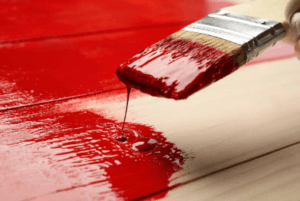Introduction to Latex Paint
Latex paint, commonly known as water-based paint, has become a significant and popular choice worldwide, including in India. Its composition predominantly includes three main ingredients: water, resins, and pigments. These ingredients work in harmony to create a versatile and effective painting solution suitable for various surfaces.
The water content in latex paint plays a crucial role as the solvent, which not only makes the paint easy to apply but also facilitates a rapid drying process. Resins, typically acrylic or vinyl, are the binding agents that help the paint adhere to surfaces and ensure durability. Meanwhile, pigments provide the color and opacity, making the paint visually appealing while offering excellent coverage.
One of the top reasons behind the widespread adoption of latex paint is its quick drying time. Users appreciate how efficiently they can complete their painting projects, often within a single day. Another notable quality is its low odor, attributed to the absence of strong organic solvents found in oil-based paints. This makes latex paint a preferable choice for indoor projects, as it poses fewer health risks and renders a more pleasant painting experience.
Additionally, the ease of cleaning up latex paint is a significant advantage. Since it is water-based, brushes, rollers, and other painting tools can be cleaned effortlessly with just soap and water, avoiding the need for harsh chemicals.
Overall, the combination of these properties – swift drying time, low odor, and convenient cleanup – has propelled latex paint to the forefront of the painting industry. Its practicality and user-friendly nature continue to make it a preferred choice for both professional painters and DIY enthusiasts across various regions, including India.

The History of Latex Paint in India
The introduction of latex paint in India can be traced back to the early 20th century when the Indian market primarily relied on traditional oil-based paints. These conventional paints, though effective, had notable drawbacks such as long drying times, strong odors, and environmental concerns. The advent of latex paint brought a significant shift in the Indian paint industry. Known for its water-based composition and faster drying time, latex paint rapidly gained attention for being more eco-friendly and user-friendly compared to its predecessors.
Initially, the introduction of latex paint in India was met with skepticism by consumers and professionals who were accustomed to the longstanding qualities of oil-based paints. However, over time, the benefits of latex paint such as ease of application, minimal environmental impact, and superior durability began to overshadow the hesitations. The turning point came in the 1970s and 1980s when Indian manufacturers started producing high-quality latex paints, further spurring its adoption.
One of the pivotal milestones in the development of latex paint in India was the rise of domestic paint companies that focused on innovating and perfecting latex paint formulations for the Indian climate. Companies like Asian Paints and Berger Paints played a crucial role in enhancing the acceptance of latex paint by introducing a range of products suited to various customer needs and preferences. These innovations made latex paint a practical and versatile choice for both interior and exterior applications.
Comparatively, the traditional paints used before the advent of latex paint, such as distemper and oil-based enamels, were limited in terms of color variety and finishes. The versatility of latex paint in offering diverse hues and textures contributed substantially to its growing popularity. Gradually, perceptions changed, and today latex paint dominates the Indian paint industry, recognized for its quality, sustainability, and adaptability to modern decor trends. The transformation in consumer behavior and professional practices underscores the substantial acceptance and evolution of latex paint in India, marking a notable departure from traditional painting materials.
Benefits of Using Latex Paint
Latex paint offers a myriad of benefits, particularly well-suited to the diverse climate and conditions found in India. One of the most notable advantages is its exceptional durability. Latex paint forms a flexible, tough surface that can withstand cracking and peeling, even in regions that experience extreme temperatures or high humidity. This makes it an ideal choice for both interior and exterior applications, ensuring long-lasting protection and aesthetics for Indian households and businesses.
Another significant advantage of latex paint is its resistance to mildew and humidity. India’s wide-ranging climates, from the tropical southern coasts to the dry northern regions, can create environments conducive to mold and mildew growth. Latex paint, however, contains antimicrobial properties that help prevent these problems, promoting a healthier living and working space. This characteristic is particularly beneficial in areas like kitchens, bathrooms, or any other high-moisture environments typical in many Indian homes.
Eco-friendliness is another crucial benefit of latex paint. Unlike oil-based paints, which release high levels of volatile organic compounds (VOCs), latex paints are water-based and emit fewer harmful chemicals. This results in better air quality inside the home or office, reducing health risks and contributing to a more sustainable environment. Many modern latex paints are now specifically formulated to be low-VOC or zero-VOC, further enhancing their appeal for eco-conscious consumers.
Ease of application and clean-up is also a key selling point for latex paint. It dries quickly, allowing for faster project completion, and is less likely to yellow over time compared to oil-based alternatives. Cleanup is also simpler; brushes and spills can be washed away using just soap and water, eliminating the need for harsh chemicals. This convenience translates into both time and cost savings, making latex paint an economical option for a wide range of painting projects.
When compared to oil-based paints, latex paint shines in many aspects, particularly for Indian households and businesses. Its advantages in terms of durability, moisture and mildew resistance, eco-friendliness, and ease of use make it a superior choice. Whether refurbishing a living space or undertaking a large-scale commercial project, latex paint offers versatile and resilient performance, meeting the unique demands of India’s varied climates and conditions.
Types of Latex Paint Available in India
In India’s vibrant and diverse market, latex paint offers homeowners and professionals a versatile range of options suitable for various applications. Broadly categorized as interior and exterior latex paints, these products are designed to meet unique performance requirements specific to their use environments. Interior latex paints are typically formulated for ease of application, durability, and smooth finish, making them perfect for living rooms, bedrooms, and other indoor spaces. Meanwhile, exterior latex paints are engineered to withstand harsh environmental conditions, providing resistance against UV radiation, rain, and humidity, ensuring lasting protection for outdoor surfaces.
The array of finishes available further distinguishes latex paints. A flat or matte finish is an ideal choice for walls with imperfections; its non-reflective nature masks surface flaws effectively. Eggshell finishes, with low sheen and better stain resistance, are a popular option for residential spaces like hallways and dining areas. Satin finishes strike a balance between sheen and durability, frequently selected for high-traffic areas due to their easy-to-clean nature. Semi-gloss paints offer a visibly shinier appearance and are commonly used on doors, trims, and kitchen cabinets, where both durability and a decorative finish are desired. For an ultra-reflective and aesthetically striking look, high-gloss latex paints are the go-to choice, often seen on furniture and accent pieces.
Several well-known brands cater to these specifications in the Indian market. For instance, Asian Paints’ ‘Apcolite’ series provides a spectrum of interior and exterior latex paints, offering everything from matte to high-gloss finishes with superior washability and color retention. Berger Paints’ ‘Rangoli Total Care’ range emphasizes comprehensive surface protection and durability, making it suitable for both household and commercial purposes. ‘Dulux’ Velvet Touch’ line stands out for its rich, velvety texture and advanced color technology, delivering a premium finish. Each of these brands also emphasizes eco-friendliness and low VOC (volatile organic compounds), highlighting a commitment to sustainable and health-conscious paint solutions.
Choosing the right type of latex paint, along with the appropriate finish and brand, is essential for achieving the desired aesthetic and functional outcomes, ensuring high-quality results that stand the test of time in varied Indian climates.

Choosing the Right Latex Paint for Your Project
When selecting the appropriate latex paint for your project in India, it is essential to consider several factors to ensure optimal results. The first step is to determine the type of surface you will be painting. Different surfaces, such as drywall, wood, metal, or concrete, may require specific formulations of latex paint to achieve durability and proper adhesion. For example, if you are painting a wooden surface, opting for a latex paint that offers good flexibility and can handle wood expansion is recommended.
Next, assess the desired finish for your project. Latex paints come in various sheens, such as matte, eggshell, satin, semi-gloss, and high-gloss. A matte finish is ideal for low-traffic areas and can help hide imperfections, while satin or semi-gloss finishes are preferable for high-traffic areas due to their durability and ease of cleaning. High-gloss finishes are often used for trim and doors as they provide a polished look and are highly washable.
It is also crucial to consider the environment where the paint will be applied. Interior paints are formulated to be more resistant to scrubbing and contact, making them suitable for walls and ceilings inside the home. On the other hand, exterior latex paints are designed to withstand harsh weather conditions, resist fading, and provide long-lasting protection against the elements.
Furthermore, color selection plays a significant role in the overall aesthetic of your space. When choosing a color, consider the existing decor and how the new paint will complement it. Neutral colors are versatile and can create a cohesive look when paired with various decorative elements. Bold colors can be used to create accent walls or highlight specific architectural features. Sampling a small area of the wall with the chosen color can help visualize the final outcome and ensure satisfaction.
By carefully considering these factors, you can confidently select the right latex paint that meets the specific needs of your project, ensuring both functionality and aesthetic appeal.

Preparation and Application Tips
Preparing surfaces properly is crucial before applying latex paint to ensure a smooth, durable finish. Start by cleaning the surface thoroughly. Remove dust, dirt, grease, and any loose paint using a mild detergent solution and a scrub brush. Rinse well with clean water and allow it to dry completely.
Next, inspect the surface for any imperfections such as cracks, holes, or rough patches. Sand these areas using fine-grit sandpaper to create a uniform surface. After sanding, wipe the surface with a damp cloth to remove sanding dust. If necessary, repair any damage with a suitable filler or patching compound, allowing it to dry and sanding it smooth afterward.
Priming is a critical step, especially when working with new, unpainted surfaces or transitioning between different paint shades. Apply a quality latex primer appropriate for the surface material, whether it be wood, drywall, or metal. Priming ensures better paint adhesion and enhances the final appearance of the latex paint.
For the painting process, choosing the right tools is essential to achieving a professional finish. Use high-quality brushes for cutting in edges and painting small areas. For larger surfaces, a roller is more efficient. Select a roller cover with the appropriate nap length based on the texture of your surface; shorter naps for smooth surfaces and longer naps for textured ones.
When applying latex paint, use smooth, even strokes. Begin with a light coat, allowing it to dry before applying additional coats as needed. Typically, two coats are sufficient for full coverage. If using a paint sprayer, follow the manufacturer’s instructions carefully, maintaining a consistent spraying distance and motion to avoid drips and uneven coverage.
By paying attention to surface preparation, selecting the right tools, and applying the paint with careful technique, you can achieve a smooth, professional latex paint finish adaptable to various surfaces in your Indian home.
Maintenance and Care of Latex Painted Surfaces
Maintaining and caring for surfaces painted with latex paint is crucial to ensure their longevity and aesthetic appeal. Routine cleaning plays a significant role in preserving the finish. For regular maintenance, gently wash the painted surfaces with a soft cloth or sponge dipped in a solution of mild soap and water. It’s essential to avoid abrasive scrubbers or harsh chemicals as they can damage the paint’s surface.
Dealing with stains on latex painted surfaces requires a delicate approach. For light stains, a mixture of water and baking soda can be effective. Apply the paste gently and then rinse with clean water. For more stubborn stains, consider using a diluted vinegar solution, gently rubbing it over the stain, and then wiping it off with a damp cloth. Avoid vigorous scrubbing to prevent removing or dulling the paint.
Touching up latex paint is relatively simple and can keep your surfaces looking fresh. Keep a small amount of the original paint for such touch-ups. Before applying new paint, lightly sand the area to ensure proper adhesion, and use a brush or roller consistent with the original application to blend seamlessly. Ensure the area is clean and dry before starting the touch-up process.
Common issues like peeling or chipping can occur if the paint was applied under unsuitable conditions or if exposed to excessive moisture. Addressing peeling requires scraping off the loose paint, sanding the edges smooth, and then applying primer followed by a paint layer. For chipping, similar steps can be followed, focusing on ensuring a well-prepared surface and proper application.
To extend the life of your latex paint job, ensure adequate ventilation in painted areas to reduce moisture buildup. Avoid placing heavy or sharp objects against painted surfaces to prevent scratches or dents. Regular inspection and prompt attention to minor issues will also contribute significantly to the durability of your paint job. By following these guidelines, you can maintain the pristine appearance of your latex painted surfaces for years to come.

Environmental Impact and Safety Considerations
Latex paint is increasingly recognized for its favorable environmental profile, particularly when juxtaposed against oil-based paints. One of the primary environmental advantages of latex paint is its lower volatile organic compounds (VOC) content. VOCs are known to contribute to air pollution and have potential health risks, including respiratory issues. By opting for latex paint with reduced VOC levels, users contribute to cleaner air and a healthier indoor environment.
When it comes to safety during application, latex paint offers several benefits. Unlike oil-based paints, latex paint generally has less odor, reducing the need for extensive ventilation. Nonetheless, it is still essential to ensure proper airflow during application to further minimize any potential inhalation of fumes. Moreover, latex paint is water-based, which makes it relatively easy to clean off brushes and other tools with just soap and water, reducing the need for harmful solvents.
Proper disposal of latex paint is another critical safety consideration. Leftover latex paint should not be discarded in regular trash or poured down the drain as it could contaminate water sources. Many communities offer recycling programs or hazardous waste disposal sites where latex paint can be safely discarded or repurposed. Users are encouraged to check local guidelines to ensure environmentally responsible disposal practices.
Eco-certifications and green labels are valuable indicators of more environmentally friendly latex paint products. Certifications such as Green Seal or the Global GreenTag provide assurance that the product adheres to stringent environmental standards. These labels take into account various factors such as the sourcing of raw materials, manufacturing processes, and overall ecological footprint, offering consumers a reliable way to identify sustainable choices.

